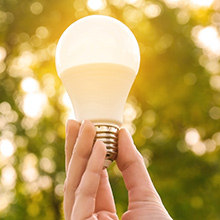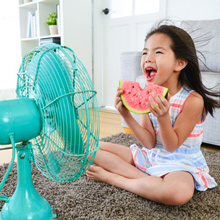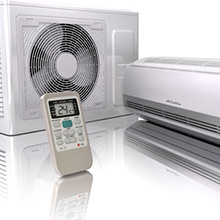Saving Energy in Your Kitchen
The kitchen is a well-used room in most homes and a place where lots of energy can be saved.
Recommendations for Reducing Kitchen Energy Usage
- Use a microwave or convection oven instead of a conventional oven. A microwave uses half of the electricity of a typical electric oven, and a convection oven uses 20% less.
- Pressure cookers and crock pots can greatly reduce cooking time for meals, and these approaches lower the amount of energy used for cooking compared to traditional electric resistance or gas stovetop or oven. These types of appliances also do not generate nearly as much waste heat as a traditional cooking methods, contributing less heat to the living space so you need less air conditioning to counteract cooking waste heat in summer months.
- Use cold water to operate the garbage disposal; it saves energy and better disposes of grease.
- Put a pan on a burner before you turn the burner on.
- Ensure pans have flat bottoms and tight-fitting lids.
- Consider the time of day when you run the dishwasher; in summer, you’ll save on air conditioning if you wait to run the dishwasher until nighttime, when your home has less of a cooling load.
Refrigerators and Freezers
 Refrigerators run year-round and can be a source of high electricity use in your home.
Refrigerators run year-round and can be a source of high electricity use in your home.
- Keep your refrigerator and freezer set to energy-efficient temperatures to avoid high bills. Set refrigerators to 37 – 40˚F so they can work at peak efficiency; set freezers to 0 – 5˚F. Keeping temperature ranges 10 degrees lower than recommended can increase energy usage by as much as 25%.
- Validate your refrigerator temperature with a thermometer placed in a glass of water at the center of the shelf.
- Understand when your refrigerator is running and how much energy it uses; BED and the Fletcher Free Library have meters you can borrow to learn more.
- A full refrigerator and freezer will use less energy than a partially full one. Plastic jugs filled with water work great to fill in the empty space.
- Locate your refrigerator in the coolest spot in the kitchen, and ensure your refrigerator has adequate clearance for proper air flow between the unit and the wall.
- Keep the exterior equipment clean by periodically brushing off compressor coils and vacuuming behind and underneath the unit to prevent build-up of dust and pet hair. Dirty coils require the refrigerator to work harder and use more energy.
- If your refrigerator is equipped with a door heater that is used to prevent condensation, there may be an ‘energy saver’ or ‘energy efficiency mode’ setting that you can activate to turn off the door heater. These small electric heaters are sometimes built into the walls of refrigerators and make the refrigerators work harder. Unless you have noticeable moisture collecting inside your fridge during the hottest part of the summer, keep the switch on the energy saving setting and save about $3 per month.
- Shut the fridge door! Keeping the door open while you load in groceries or choose a snack causes the compressor to run more, and actually will result in a warmer kitchen overall.
Buying Refrigerators
- A used refrigerator may seem attractive as they can quite inexpensive, but life cycle costs for second-hand equipment can be surprisingly high. Did you know that a typical pre-1990s 18-cubic-foot refrigerator will consume about $1,500 to $2,000 worth of electricity during the course of its 20-year life?
- ENERGY STAR-labeled refrigerators use 60% less energy than traditional options, so lower your future bills by opting out of buying a used fridge. It is less expensive to replace your older fridge with a new, high-efficiency model and finance the expense for a few years rather than buying a much less expensive energy guzzler. The savings on the electric bill can offset the monthly finance charge.
- Refrigerator configuration greatly affects the efficiency of the appliance. Refrigerators with top or bottom freezers are typically much more energy efficient than a side-by-side door model, with the freezer on one side and the refrigerated section on the other.
NOTE: BED offers rebates on refrigerators only for rental residential dwellings. We do not offer rebates on refrigerators for owner-occupied residences or for commercial properties.
Stovetops
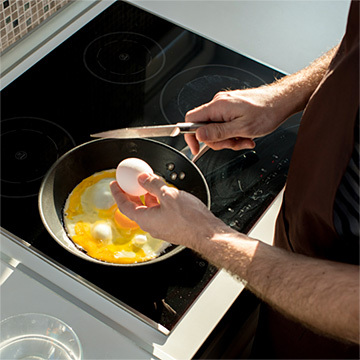 By electrifying your cooking, your household is playing a part in Burlington’s transition to Net Zero Energy, and our call for a reduction in, and eventual elimination of, fossil fuels.
By electrifying your cooking, your household is playing a part in Burlington’s transition to Net Zero Energy, and our call for a reduction in, and eventual elimination of, fossil fuels.
There are many benefits to induction cooking, including immediate heat response, accurate temperature control, nearly twice as fast water heating compared to gas or standard electric with greater energy efficiency. Since its surface is completely sealed, there’s no exposed heating element or open flame, and it is easier to clean. Your kitchen stays cooler and less heat is wasted, since the cooktop’s heat is focused on the pan.
Cooktop Rebate
We are now offering a rebate of up to $200 on the purchase of a new electric induction cooktop when replacing a non-electric cooktop.
Considerations when purchasing an Induction Cooktop or Range
- Not all cookware is compatible with an induction cooktop. You can test whether a piece of cookware is compatible by placing a refrigerator magnet on it. If it sticks, it’s compatible.
- A 220 volt outlet is required. If one is not already behind the stove then you will need to hire an electrician to install one.
- Although induction cooking is more efficient at turning energy into heated food than natural gas, the lower price of natural gas means that a typical residential customer can expect to spend $10-20 more heating food per year.
Dishwashers
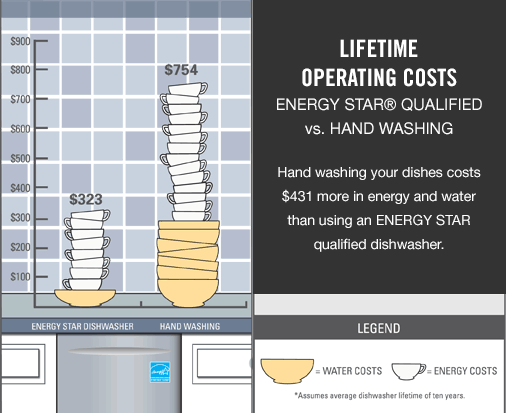
- Equipped with advanced features that boost efficiency and cleaning performance, ENERGY STAR-certified dishwashers can cut water usage by 15% and energy consumption by 5% – 55%; you’ll save closer to the high end of the range if you wash with cold water or if you’re replacing an older machine. Dishwashers designated as Most Efficient deliver increased energy savings.
- A traditional dishwasher may cost $75 a year to run, while an ENERGY STAR dishwasher costs $40 less per year: $35 a year to run, and will save 3,870 gallons of water over its lifetime.
- Select low-heat or no-heat drying options to minimize the operation of the electric heating element, which contributes the most to energy use.
- Only run the dishwasher when there is a full load.
- The amount of energy your dishwasher consumes during the washing cycle is dependent on the temperature setting of your water heater. A more efficient water heater allows your dishwasher to work less hard.
Purchasing Dishwashers
- A used dishwasher may seem attractive, but life cycle costs for second-hand equipment can be surprisingly high.
- Read the yellow EnergyGuide label to understand potential operating costs and compare efficiencies and annual costs of different machines.
- Size your dishwasher appropriately for your home. Running a compact-capacity model multiple times uses more energy than running a standard-capacity model once.
- Select a model with several wash cycle options so you can choose a light or energy-saving wash cycle when your loads are lighter or less soiled.
More Ways to Save
LED Lighting & ControlsLED lighting uses 25% of the energy that incandescent bulbs do and last 25 times longer. |
Stay Cool at HomeReduce the amount of money you pay to stay comfortable during hot weather. |
Cold Climate Heat PumpsA Cold Climate Heat Pump may be able to reduce your heating and cooling costs. |


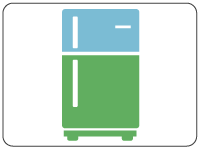 Refrigerator for Rental Properties
Refrigerator for Rental Properties Induction Cooktop
Induction Cooktop